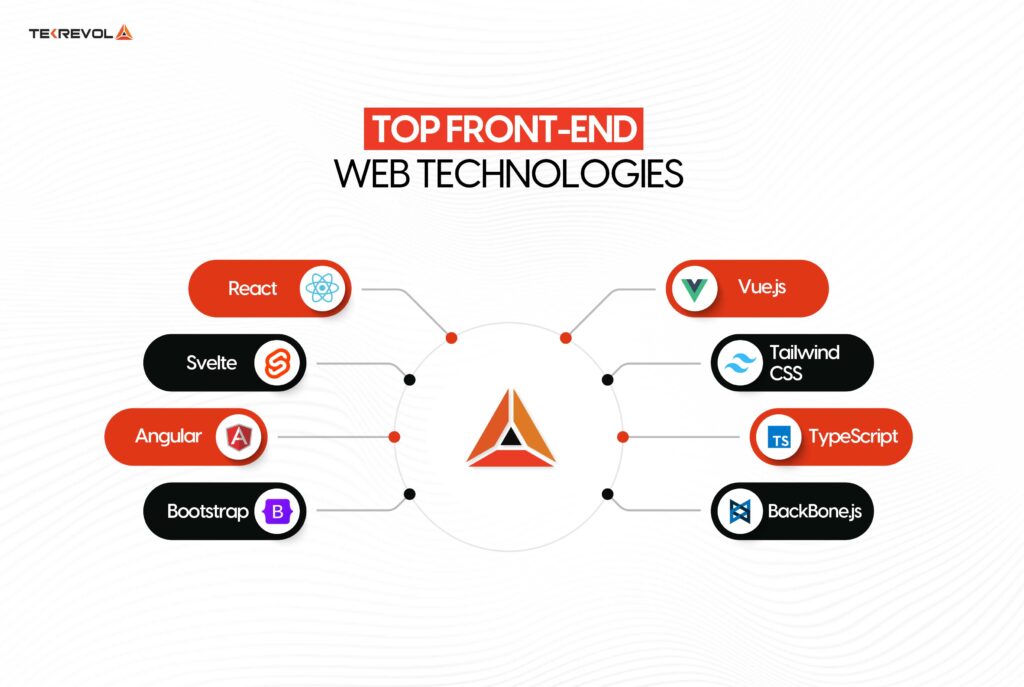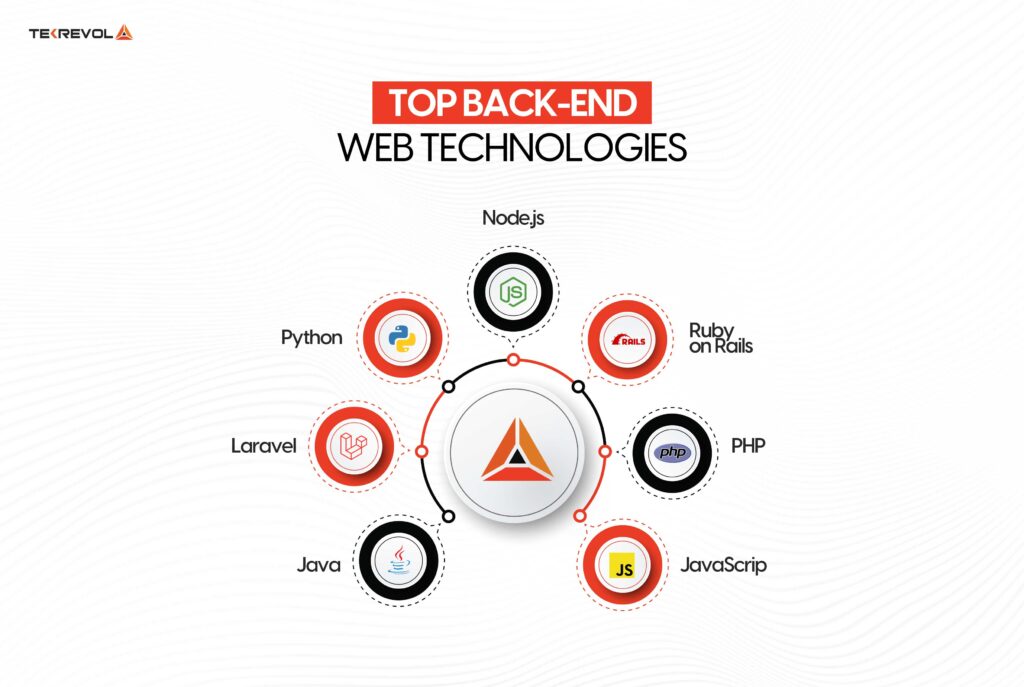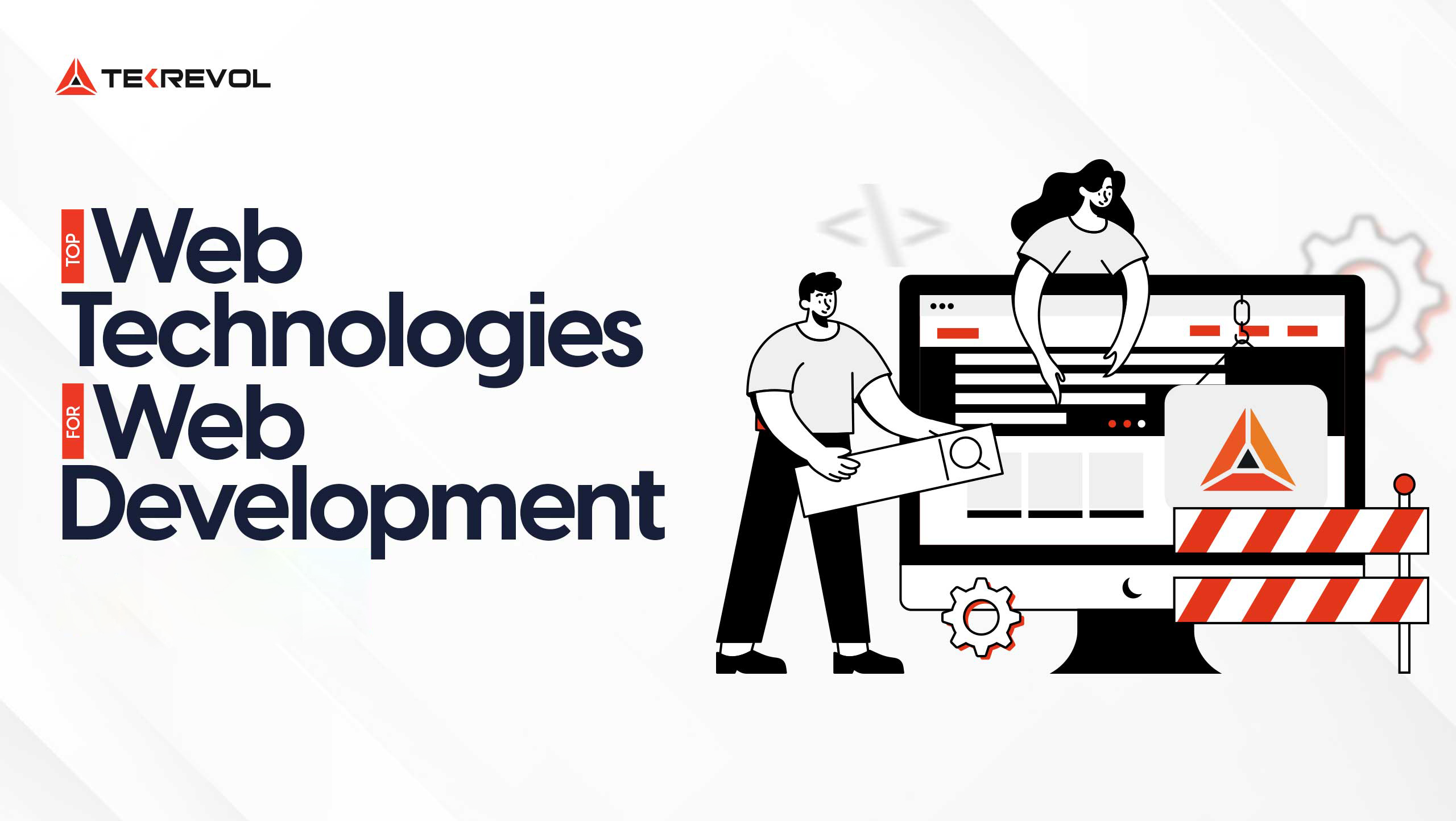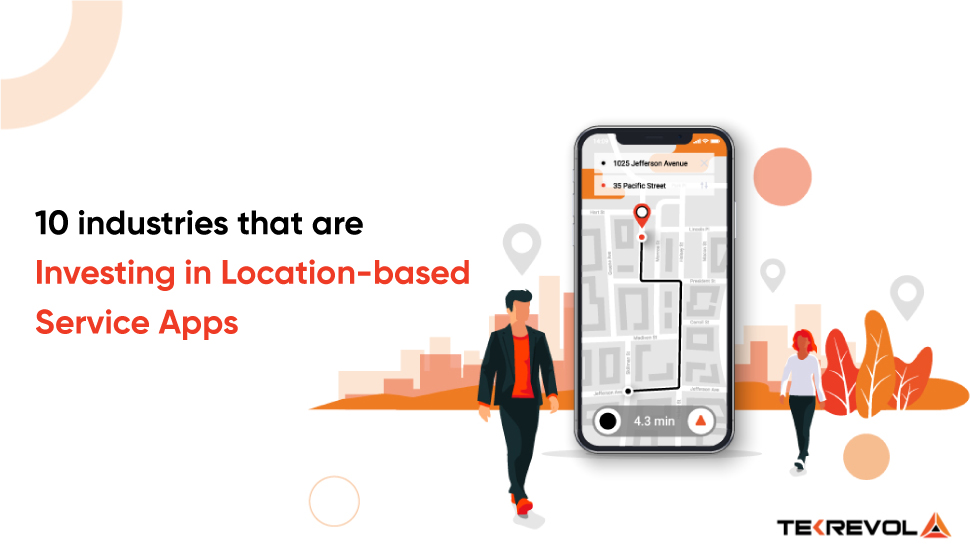As we progress into 2025, the world of web development is becoming more exciting than ever! The latest web technologies aren’t just there to bring more web features to the queue – but it’s transforming how we used to create, design, and experience the digital world.
From AI-powered development tools to instantaneous frameworks, web application development technologies have introduced developers to a whole new era of applications that feel smarter, faster, and more personal.
However, having so many web technologies being easily available today, picking out the best one can turn out to be a daunting task. Hence, here is a detailed guide that drives you through the most impactful and powerful web technologies that are being used in 2024.
Top Front-End Web Technologies

What is the very first thing that comes right away as soon as you open a website? The home screen, right? That’s you interacting with the front end of the website.
The right web technologies for front-end development, as recommended by a top web development company, elevate user experience, ensure faster load times, and urge the user to keep coming back to your website.
Here’s what’s been shaping the top front-end web development technologies in 2024:
1. React
Flexibility, performance, and strong community features have maintained React to be among the top web technologies used to craft front-end web applications.
You will be surprised to know that the most popular social platform, the one and only Facebook, is the mastermind behind React. This web technology was created to ease the development process of interactive UIs – especially for a single-page application that focuses on providing outstanding user experience and reduced load time.
Why React Still Reigns Supreme in 2024?
- Performance and Optimization: React’s virtual DOM enables developers to build very dynamic interfaces without compromising on its speed.
- Vast Ecosystem: From Next.js for enabling server-side rendering and Redux for efficient state management, React’s rich ecosystem helps developers build feature-rich applications.
- Community and Support: The huge support from the community keeps React updated with the new best practices and integrations.
Main Updates in 2024:
With React 18, concurrent rendering has been improved; thus, it’s easier to build complex, responsive apps. For large applications, React Server Components also offer a new way of handling data-heavy applications, streamlining performance and reducing load times.
React Alternatives:
Although React is the leader of the pack, Vue and Svelte are also quite real rivals. So, let’s tackle those next.
2. Vue.js
Vue.js is a powerful and simple web technology and development framework. Since it was introduced to developers, it has created quite a fandom of its own, especially in Asian companies that require flexible and scalable web application development technologies due to its ease of learning curve and adaptability.
Why is Vue.Js Gaining Popularity?
- Flexible and Lightweight: Vue can operate as a library while adding specific features to certain parts of a website or as a full-featured framework for creating complex applications.
- The Vue Ecosystem: Tools and plugins, including the Vue CLI, the router and Vuex, help ensure smoother development-that would make this tool to be the perfect choice for most modern projects.
When to Choose Vue Over React?
Vue would be a good choice for projects where simplicity and speed to market are the main necessities. It’s most suitable for smaller projects or applications where extensive front-end functionality is not required.
3. Svelte
Svelte, the latest front-end web technology, is proving to be revolutionary. It compiles components down at build time to integrate JavaScript, eliminating the need for a virtual DOM and thus reducing the burden on the browser.
The Advantages of Svelte:
- No Virtual DOM: Svelte compiles code during build time, making applications faster and more efficient.
- Fewer Bundle Sizes: As there is no framework code in the client bundle, applications developed on Svelte web technology are developed quickly with great efficiency.
Why is Svelte Likely the Future of Front-End Development?
Svelte has some specific strengths that make it a good option for small applications as much as for large ones, especially if performance is listed at the top of their requirements list.
Being a leading web application development technology, Svelte appeals to developers looking to optimize resource usage and turns out very useful in resource-intensive applications or edge computing.
4. Tailwind CSS
Although Tailwind is not a JavaScript framework, it is a utility-first CSS framework that has greatly impacted web design technologies. It presents low-level utility classes that can be combined to build direct custom designs from HTML without leaving the document.
Benefits of Tailwind in Modern Web Design:
- Customizability: Tailwind enables developers without much CSS writing experience to produce interesting designs.
- Utility classes: The utility classes are helpful in implementing responsive layouts so the user experience is smooth on all devices. This provides the ability to make quick design changes, hence facilitating faster prototyping.
Tailwind vs. Traditional CSS Frameworks:
Tailwind is more flexible compared to traditional web development technologies such as Bootstrap. While Bootstrap’s components are predefined, Tailwind enables the developers to create designs that do not look like templated frameworks.
5. Angular
Angular, another front-end framework maintained by Google, is still hot in the market of web technologies. Particularly favored to deal with large-scale applications, it is widely used because of its strong construction, modular architecture, two-way data binding features, and ample other fruitful reasons.
Why Angular Remains Popular in 2024?
- Full Framework: Unlike light libraries, Angular provides a fully featured framework including internal dependency injection, routing, and form handling.
- TypeScript Support: Angular is made of TypeScript and makes web design and development more predictable and manageable, specifically in complex applications.
- Enterprise-level features: Given Angular’s extensive tooling and scalable architecture, it’s pretty necessary for enterprise applications where maintainability and reusability of an application are the main concerns.
Use Cases for Angular:
Angular is particularly suitable for web development technologies that demand a formalized approach, such as e-commerce platforms, CMS, or big dashboards. It keeps the code very organized and testable, which is super important for large teams of developers working on high-traffic, data-intensive applications.
6. TypeScript
A superset of JavaScript, Bootstrap adds static typing to the language in order to improve the quality, readability, and maintainability of the code. Since it can detect errors during the development process before problems arise in production, this makes it the preferred language for many developers working on web application development technologies.
Why TypeScript is Critical in 2024:
- Prevention of Error: TypeScript prevents errors at compile time, which makes the code much more reliable and lowers the issues at runtime.
- Scalability: TypeScript is very beneficial for large codebases, and it makes it easy to maintain and refactor code, especially when projects are huge!
- Broad Framework Support: TypeScript is the language of choice for several popular web development technologies like Angular, as well as libraries like React and Vue, making it highly versatile.
Use Cases for TypeScript:
TypeScript is a very valuable resource for complicated or long-term projects. It makes use of autocompletion, refactoring tools, and static analysis to increase developer productivity and is a very popular tool in the market of web design technologies, especially for high-stakes applications where reliability is critical.
7. Bootstrap
Among the most popular technologies for creating responsive and mobile-first web applications, Bootstrap leads the band. With pre-designed components and CSS utility classes, Bootstrap allows developers to create visually attractive, responsive websites that can be developed with the bare minimum amount of coding!
Why Bootstrap is Preferable in Web Design in 2024
Bootstrap comes with pre-built Components for Bootstrap, which include a library of pre-made elements, including layouts like navigation bar, buttons, and forms, that make this web design technology easily customizable.
- Responsive Grid System: With Bootstrap, the grid system offers developers easy layouts that swap perfectly to work well in various screen sizes. Bootstrap enables the integration of both CSS and JavaScript functionality, making most interactive elements quite easy to develop.
- Use Cases of Bootstrap: Perfect for projects that would need a clean, professional look without much custom CSS.
8. BackBone.js
Backbone.js is a small JavaScript library that provides the backbone for a developer to structure code with web applications. It follows an MVC architecture and includes tools for creating models that bind via key-value with custom events, so it can easily handle the complexity of dynamic applications.
Why Backbone.js Still Matters in 2024
- Flexibility and Simplicity: Unlike full frameworks, it is a lightweight and minimalistic framework that allows developers to add only what they need for their applications.
- Increased Control: Backbone.js provides a developer with total control over their architecture, making it highly adaptable to various web development technologies and unique project requirements.
- Compatibility with RESTful APIs: Since backbone.js supports applications built on top of RESTFUL APIs, it lets developers sync the front-end with back-end data with ease.
- Ready to Take Your User Experience To the Next Level?
- Enjoy A Free Consultation For Choosing The Best Front-end Frameworks
Top Backend Web Technologies

Choosing the right back-end web development technologies is very important for efficient, scalable, and secure development. Let’s dive a little deeper into some of the best ones to consider in 2024.
1. Node.js and Deno
Node.js is revolutionizing back-end web development technology that allows developers to use JavaScript on the server side. Deno, developed by the creator of Node.js, is a new, secure runtime environment that is built in TypeScript.
Why you should go with Node.js in 2024:
- Asynchronous Processing: Node.Js is a non-blocking architecture that enables it to handle multiple requests at the same time, making it perfect for high-traffic applications.
- Express.js and Nest.js: Express is too minimalistic in its framework, whereas Nest.js is a little more structured for building enterprise-level applications.
Deno’s Growth:
Deno addresses most of Node.js’s security issues, provides default security measures, and supports TypeScript natively. All in all, this is a great project where the main task is to develop a robust and secure application.
2. Python and Django/FastAPI
Web development technologies continue to be dominant, especially with applications that require rapid prototyping and maintenance. Django and FastAPI are two of the best frameworks of Python that deal with the various stages of the development process.
Why Python Continues to Thrive?
- Ease of Use and Readability: Python’s simple syntax makes it accessible and versatile.
- Libraries and Tools: Python has an enormous collection of libraries, making it easy to implement. You can use Python with modern trends like Machine Learning, Data Analysis and more related tools efficiently within the project.
Choosing Between Django and FastAPI:
- Django is a very comprehensive framework suitable for full-stack web applications that comes with features like ORM and built-in templates.
- FastAPI is an asynchronous framework created to be a quick way to integrate your existing projects with RESTful APIs. Fast API is optimal when performance is crucial!
3. Ruby on Rails
Ruby on Rails, or simply Rails, is another mature and popular web technology. Since it makes development quick and suitable for MVPs (minimum viable products) and smaller projects, it’s loved by web developers all over the world.
Ruby on Rails in 2024:
- Rapid Development: Many features of Rails are pre-configured, such as scaffolding, so that applications can be quickly built and deployed.
- Great for Startups: Rails has been a choice for companies like GitHub, Shopify, and Airbnb because of its simplicity and scalability.
4. PHP and Laravel
Some people may think PHP to be an outdated language, but it is as good as there are frameworks like Laravel that take the presence of PHP to a whole new level.
PHP Endures Web Development
PHP is the power behind most of the modern web technologies, mainly because it is easy to work with and widely available in hosting services. Laravel made even more modernization of PHP’s capabilities and features.
Laravel is the New Dominating PHP Framework:
Laravel contains all features of routing, middleware, and authentication. So, this one is a solid candidate for any large-sized web application.
5. Java
Java is the most effective and most commonly applied programming language in the world and is still strongly used for Web application development in 2024. Java is very portable, scalable, and secure; hence, many make it easy to use in the back-end development of complex, large-sized applications.
Why is Java the best for Back-end Development in 2024?
- Platform Independence: Java’s “write once, run anywhere” philosophy allows applications to be deployed across various platforms without modification.
- Scalability: As Java’s primary goal is to create high-performance applications, it fits well with enterprise-level web development projects where high reliability is needed.
- Vast Ecosystem: Java has a vast ecosystem of frameworks like Spring and Hibernate and comes with rich libraries that make back-end development easier for the developers.
6. JavaScript (Server-side)
While most people think of JavaScript as being front-end, it’s not. With the rise of Node.js, it has become a popular web technology for back-end development. Its ability to run on both the client and server sides makes JavaScript to be one of the most versatile web development technologies in 2024.
Why is JavaScript perfect for back-end development?
-
- Unified Language Across the Stack: JavaScript is used on both the frontend and backend, reducing the context switches for developers and resulting in a more unified codebase.
- Event-Driven Architecture: JavaScript is asynchronous and non-blocking, making it extremely efficient to deal with multiple requests in time, hence perfect for real-time applications.
- Strong Community and Ecosystem: Node.js, Express.js, and a variety of other libraries make JavaScript a powerful option for building scalable, high-performance back-end systems.
- Is your back end ready for 2024?
- Learn about the latest back-end technologies that deliver power, scalability, and security to your applications.
10 Best Emerging Web Development Trends of 2025
Well, now that you know everything about popular web development technologies – isn’t it a great move to learn about the best-emerging web development trends, too – as integrating the latest trends on popular web technologies will surely be the deadliest combo!
| Trend | Description |
| AI-Driven Development | Make use of AI for generating, debugging, testing and personalizing codes. |
| Voice Search Optimization | Optimizing web applications for voice-activated search and voice-based features. |
| WebAssembly (Wasm) | Enhances performance by allowing users to run code written in various languages to run on the web efficiently. |
| Edge Computing | Reduced latency and cost-effective scaling through serverless functions |
| Micro-Frontends | Decomposing front-end apps into smaller and independent modules. |
| Progressive Web Apps | Continue growth in PWAs, especially in areas with low net connectivity |
| Low-Code Development | Allow users to build applications without extensive coding knowledge |
| Blockchain and Web3 Integration | Blockchain-backed security, decentralized data, and app development |
| Dark mode Standardization | Experience high accessibility and energy-saving on OLED screens with Dark mode |
| Improved Cybersecurity Standards | Enhanced focus on security protocols such as MFA, Zero Trust, and secure coding practices. |
-
AI-Driven Development
AI-driven development changes the way developers work, allowing them to automate tedious work and provide sophisticated tools for debugging, code generation, and even testing.
For instance, using GitHub Copilot and OpenAI Codex, programmers could accelerate their programming, generating code snippets and fixing mistakes more quickly.
It also gives capabilities for personalized user experiences like intelligent recommendation systems and chatbot engagements that help improve user interactions.
-
Voice Search Optimization
Voice search optimization has become indispensable due to the rise of smart speakers and voice-activated appliances.
Voice search-optimized websites rank higher, especially when the users are on the go, and they depend on devices like Alexa, Google Assistant, and Siri to help them surf the web.
Websites that are optimized with voice search aren’t only loved by the users but have the tendency to help you earn some free bucks from it.
-
WebAssembly (Wasm)
Well, WebAssembly or Wasm is transforming web application development technology, enabling code to run on the web – more legibly written in languages like Rust, C, and C++.
Suppose you only do a little digging on WebAssembly. In that case, the results you might receive will be something like “Wasm is useful for any computationally intensive applications from video processing and CAD tools to game engines that may suffer in a JavaScript-based environment.”
Wasm makes high-performance applications accessible within browsers, taking the web technologies possibilities to a whole new level.
-
Serverless and Edge Computing
Serverless and edge computing are reshaping application architecture. Serverless systems, such as AWS Lambda and Google Cloud Functions, enable developers to deploy code without managing server infrastructure -making things super scalable and effortless.
For applications requiring real-time responses, edge computing cuts down their latency by processing data closer to the user. These web technologies allow applications to be deployed with low latency and cost-effectively.
-
Micro-Frontends
Micro-frontends are an emerging architectural style within highly complex front-end applications. They are enabled by breaking a front-end application into smaller modules managed by multiple teams, allowing more agile and scalable developments. Micro-frontends allow features to be deployed independently, which increases the chances of an update being in place and reduces the likelihood of front-end failure.
-
Progressive Web Apps (PWAs)
Progressive Web Apps (PWAs) are gaining popularity, particularly in areas with relatively low internet access. PWAs enable an app-like experience on the web with features such as offline access and background sync, and they also keep users updated with push notifications.
PWAs are lightweight in footprint and easy to install (no app stores necessary). Compared to native apps, they seem to be the cost-effective choice, enabling businesses to grow their reach with minimal investment in developing different mobile apps.
-
Low-Code/No-Code Development
Low-code and no-code platforms allow newbies and professional developers to develop applications with minimum coding.
These platforms offer drag-and-drop interfaces, prebuilt components, and workflows to accelerate the process of prototyping and development. Today, companies are employing low-code solutions for their internal tools, MVPs, and even full-scale applications these days, reducing the necessity to have special programming skills and time-to-market.
-
Blockchain and Web3 Integration
Blockchain and Web3 integration is transforming web application development technology into decentralized and secure solutions. Web3 enables blockchain-based applications, often referred to as dApps, focusing strongly on putting the security of the user, ownership of data, and control of data at the core.
Web3 integration allows businesses to leverage the availability of decentralization and security based on blockchain. Today, these emerging web technologies are trending in finance, supply chain management, and even social media.
-
Dark Mode Standardization
Dark modes have now become a standard necessity across all platforms, as users are increasingly preferring darker interfaces. Apart from making screens look aesthetically pleasing, dark mode also increases accessibility for light-sensitive people.
It also saves battery life on OLED screens, allowing the device to run for a little longer. In 2024, Dark mode will no longer be just about aesthetics; it will improve user experience and accessibility.
-
Upgrade Cybersecurity Standards
Improved cybersecurity standards are important to counter the growing propensity of cyber threats. Developers thus concentrate on protocols like MFA and Zero Trust architecture to develop secure coding practices and protect user data.
Also, frameworks like CSP, vulnerability assessments, etc., are becoming routine for safeguarding websites from threats like XSS or SQL injection.
- Want to future-proof your web projects?
- Uncover the emerging trends in web development today!
Conclusion
Technology in web development is setting the ground for the dynamic, responsive, and secure landscape of digitization in 2024. As we discussed above, from AI-driven tools and modular front-end frameworks to the leading back-end solutions out there, the available web technologies that developers can use today are deeper and more diverse than ever.
The speed at which web application development technologies evolve demands careful attention to emerging trends and continuous exploration of the opportunities new web design technologies offer.
Therefore, from the developer building user experiences to the executive strategizing the next big digital move, these tools will put you in the best position to keep going forward. The web is ever-evolving and there are no bounds on what we can build. The future is now in our hands; let’s take advantage of it!

 5341 Views
5341 Views November 27, 2024
November 27, 2024









